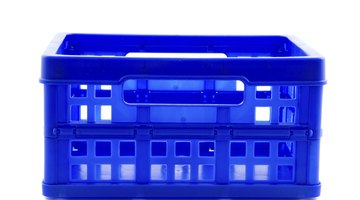How to Build a Milk Crate Bed Frame
Table of Contents
You can up a simple bed frame -- in practice, more of a bed platform -- using a series of sturdy plastic milk crates -- either square ones 13 by 13 by 11 inches, or the rectangular alternative, the same height and width but 19 inches long. A milk-crate bed platform is endlessly customizable as well.

Turn crates on their sides for cubby-style storage under the bed, or stash a power strip and power supply beneath a crate for a built-in electronics charging station.
Measurements Matter
Measure your mattress to determine how many crates you'll need. A basic full-size mattress or futon mattress measures 54 inches wide, 75 inches long, while a twin mattress is 39 inches wide, 75 inches long. If the crates have ridges that make them a bit awkward to measure, press four or five against one another and measure the row. Keep adding or removing crates until you have a row at least an inch wider than your mattress and a column at least an inch longer than your mattress.
Multiply the number of crates in a row by the number of crates in a column to find out exactly how many you'll need. For a full-size bed with square milk crates, you'll need six rows of five crates -- 30 crates -- for a full platform, for instance.
Clean Those Crates
If the milk crates are dirty -- if they are used, they most likely are -- hose them off outdoors. Wipe them down with a household cleaner and a sponge, using a nylon scrub brush to clean off excessive dirt and debris. If the plastic on some of the crates is rough enough to feel almost sharp, smooth the plastic with fine-grit sandpaper, then wipe it down with a damp cloth. Sharp plastic may scratch the floor or snag the carpet.
Building the Bed
Arrange crates row by row, separated slightly at first, to plot the bed layout. Customize the look by alternating two colors, or by arranging them in a color order that looks the best to you. Once you are happy with the look, connect each crate to the adjacent crate using at least two zip ties, working row by row, adding the zip ties through the holes in the sides of the crates.
Connect each row to the one below it in the same fashion so every single crate has several ties connecting it to each of its neighbors. Tighten the zip ties to remove all the slack so the crates do not shift when in use. Place a regular mattress or futon mattress atop the crates when complete. No box spring is necessary, since the crates fully support the mattress.
Slight Modifications
For a cubby-style bed, arrange the crates so the open ends face out, or alternate them so every other cube faces out. If you are concerned about the crates leaving marks in the bottom of your mattress, cut a sheet of interior 3/4-inch plywood to fit the top of the crate frame. Paint all the crates, if desired, using spray paint, working outdoors in a well-ventilated area. Snake a power strip through the holes in one crate to a nearby outlet to have a place to charge your phone or tablet near the bed.
Real Milk Crates, Legally
Many milk crates found at yard sales or on the curb on a trash night state that the crate legally belongs to a particular dairy. Instead of snagging crates that may not legally be yours to own, purchase real, new milk crates from a manufacturer or distributor. This way, the crates are clean and fresh and you'll be able to obtain the exact quantity you'll need.
The Drip Cap
- You can up a simple bed frame -- in practice, more of a bed platform -- using a series of sturdy plastic milk crates -- either square ones 13 by 13 by 11 inches, or the rectangular alternative, the same height and width but 19 inches long.
- Once you are happy with the look, connect each crate to the adjacent crate using at least two zip ties, working row by row, adding the zip ties through the holes in the sides of the crates.
- No box spring is necessary, since the crates fully support the mattress.
- Many milk crates found at yard sales or on the curb on a trash night state that the crate legally belongs to a particular dairy.
- This way, the crates are clean and fresh and you'll be able to obtain the exact quantity you'll need.
Resources
Writer Bio
Kathy Adams is an award-winning writer. She is an avid DIYer that is equally at home repurposing random objects into new, useful creations as she is at supporting community gardening efforts and writing about healthy alternatives to household chemicals. She's written numerous DIY articles for paint and decor companies, as well as for Black + Decker, Hunker, Landlordology, SFGate and others.
Photo Credits
- EllenMol1814/iStock/Getty Images
- EllenMol1814/iStock/Getty Images
More Articles



